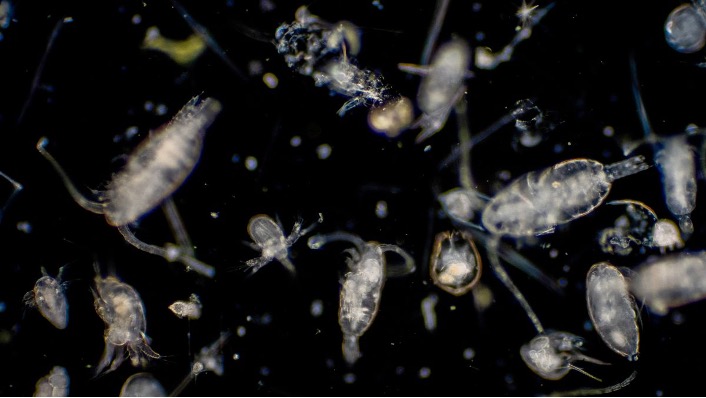Scientists from the TARA expedition are continuing to analyse the samples collected during their expeditions, with the aim of making a broader inventory of planktonic biodiversity. New viruses have just been discovered infecting plankton around the world. Their strange links with giant viruses or the better known virus responsible for herpes could provide a better understanding of the origin of this viral infection.
by Laurie Henry
Unpublished ocean viruses
The data obtained from nearly 35,000 water samples collected from around the world during their expeditions between 2009 and 2013 were analysed by TARA OCEAN scientists.
This work revealed a new group of DNA viruses, shaped like the herpes virus. These viruses infect eukaryotes (organisms with cells with a nucleus containing genetic material) but they share a key enzyme with giant viruses (very large viruses, up to 2 µm in length). Scientists have named this group mirusviruses, from the Latin word mirus meaning surprising or strange.
Viruses are defined as infectious agents. They can only multiply when they infect a host. They are found in a wide range of environments, but those in the oceanic environment remain particularly under-researched.
Tom Delmont, an expert in microbial ecology at the CNRS and co-author of this recent work published in the journal Nature, explains in a press release:
« In 2018, our research team observed an unusual evolutionary signal in the tsunami of sequencing data from Tara Oceans. The follow-up of this signal allowed us to discover and then characterize a major group of DNA viruses: the mirusviruses. The publication of this discovery in the journal Nature is the beginning of a new adventure as it gives the scientific community the keys to detect and study mirusviruses in many ecosystems ».
A global distribution within the ocean plankton
Oceanic mirusviruses appear to be among the most abundant eukaryotic viruses present in the upper 200 m of the ocean. They are abundant all over the world, from the equator to the poles. TARA OCEAN scientists have identified seven different families of mirusviruses, spread across the globe. Three were found exclusively in the Arctic Ocean, while one was specific to temperate waters.
Complex and with amazing genomes (the entire genetic material of a living being), these mirusviruses seem to affect a large number of planktonic cells and play a key role in the marine ecosystem. Planktonic ecosystems contain a phenomenal reservoir of life: it is estimated that more than 10 billion organisms inhabit each litre of water. For this reason, scientists consider the importance of oceanic plankton for the Earth’s climate to be at least equivalent to that of the rainforest, even though only a very small fraction of the organisms that make up oceanic plankton are currently classified as being of any significance.
Viruses essential to ocean and human health
For the authors of the study, these viruses are a vital part of the plankton and the ocean surface environment, just like our intestinal flora. By invading plankton cells, mirusviruses help regulate the activity of micro-organisms, and thus the flow of carbon and nutrients through the ocean. In concrete terms, the viruses destroy the cells while returning nutrients to the ecosystem, which encourages the renewal of plankton activity. Plankton help to absorb and fix carbon dissolved in surface water, in particular through photosynthesis (production of organic matter from mineral matter, including carbon, and light energy)..

Mirusviruses regulate plankton activity and contribute to the health of marine ecosystems. ©ShutterstockTom Delmont explains: “Viruses are a very natural component of plankton on the surface of the ocean. They will destroy many, many cells every day and this will release nutrients, particles inside the cells that will be used by other cells to be active and healthy”.
This research has shown that all the key genes of viruses, forming their viral particle (i.e. the infectious particle of the virus made up of its genetic material and proteins) and defining the identity card of DNA viruses, have a direct evolutionary link to herpes viruses. They may therefore hold the key to solving the enigmatic origin of these viruses in humans in particular.
Towards a planktonic origin of herpes?
The herpes virus causes severe infections, which can lead to painful blisters or ulcers. Treatable but not curable, it is spread mainly through skin-to-skin contact and affects more than 3.7 billion people worldwide.
The discovery of mirusviruses suggests that the ancestors of herpes viruses once infected single-celled marine organisms. Tom Delmont added: ” This means that there is a shared evolutionary history between herpes, which only infects animals, and mirusviruses, which are all over the ocean infecting single-celled organisms. All this points to a planktonic origin of herpes”.
Despite the obvious link to herpes viruses, the majority of mirusvirus genes, including those involved in viral genome replication, are similar to those of giant viruses. This evolutionary ‘chimerism’ of mirusviruses, i.e. the cohabitation of different genetic material within the same organism, as explained by the authors, is unique and could provide insight into the evolution of DNA viruses, such as smallpox or hepatitis B.
